A Guide to Yellow Oral Mucosal Entities: Etiology and Pathology
- PMID: 30693453
- PMCID: PMC6405798
- DOI: 10.1007/s12105-018-0977-4
A Guide to Yellow Oral Mucosal Entities: Etiology and Pathology
Abstract
When faced with an uncertain clinical pathosis in the oral cavity, identifying the color of the mucosal lesion helps to narrow down a differential diagnosis. Although less common than red and white lesions, yellow lesions encompass a small group of distinct mucosal pathologic entities. Adipose tissue, lymphoid tissue, and sebaceous glands are naturally occurring yellow constituents of the oral cavity and become apparent with associated developmental or neoplastic lesions. Reactive and inflammatory lesions can create a yellow hue due to purulence, necrosis, and calcification. Some systemic diseases are known to deposit yellow bi-products such as amyloid or bilirubin into the oral mucosa of an affected person, and while not always yellow, unusual entities like verruciform xanthoma and granular cell tumor fall under the umbrella of yellow lesions given their occasional propensity to demonstration the color. This chapter aims to explore the unique group that is yellow lesions presenting in the oral mucosa.
Keywords: Mouth; Mucosal; Oral cavity; Oral manifestations; Systemic disease; Yellow.
Conflict of interest statement
Conflict of interest
All authors declare that they have no conflict of interest.
Ethical Approval
This article does not contain any studies with human participants or animals performed by any of the authors.
Informed Consent
As no human participants were involved in a study, informed consent was not required.
Figures
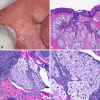
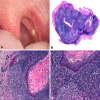
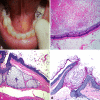

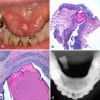
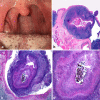
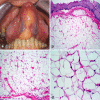
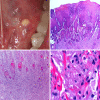
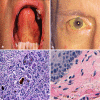

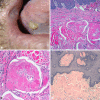
Similar articles
-
Oral verruciform xanthoma.BMJ Case Rep. 2015 Mar 27;2015:bcr2014209216. doi: 10.1136/bcr-2014-209216. BMJ Case Rep. 2015. PMID: 25819830 Free PMC article.
-
Pigmented lesions of the oral cavity: review, differential diagnosis, and case presentations.J Can Dent Assoc. 2004 Nov;70(10):682-3. J Can Dent Assoc. 2004. PMID: 15530266 Review.
-
Erythematous and Vascular Oral Mucosal Lesions: A Clinicopathologic Review of Red Entities.Head Neck Pathol. 2019 Mar;13(1):4-15. doi: 10.1007/s12105-019-01002-8. Epub 2019 Jan 29. Head Neck Pathol. 2019. PMID: 30693460 Free PMC article. Review.
-
Verruciform xanthoma and concomitant lichen planus of the oral mucosa. A report of three cases.Int J Oral Maxillofac Surg. 1999 Feb;28(1):62-6. Int J Oral Maxillofac Surg. 1999. PMID: 10065655
-
Pathology of intraoral sebaceous glands.J Oral Pathol Med. 1993 Jul;22(6):241-5. doi: 10.1111/j.1600-0714.1993.tb01065.x. J Oral Pathol Med. 1993. PMID: 8355222 Review.
Cited by
-
Oral granular cell tumor: a collaborative clinicopathological study of 61 cases.Oral Maxillofac Surg. 2024 Sep;28(3):1383-1397. doi: 10.1007/s10006-024-01272-9. Epub 2024 Jun 21. Oral Maxillofac Surg. 2024. PMID: 38904898
-
Occurrence of Recurrent Aphthous Stomatitis (RAS) as a Rare Oral Manifestation in a Patient with Gilbert's Syndrome.Case Rep Dent. 2021 Apr 16;2021:6648729. doi: 10.1155/2021/6648729. eCollection 2021. Case Rep Dent. 2021. PMID: 33953989 Free PMC article.
-
Oral Verruciform Xanthoma of the Lower Lip: A Rare Entity.Cureus. 2024 Nov 9;16(11):e73352. doi: 10.7759/cureus.73352. eCollection 2024 Nov. Cureus. 2024. PMID: 39659335 Free PMC article.
-
Oral Lymphoepithelial Cyst: A Collaborative Clinicopathologic Study of 132 Cases from Brazil.Head Neck Pathol. 2022 Mar;16(1):268-277. doi: 10.1007/s12105-021-01352-2. Epub 2021 Jun 29. Head Neck Pathol. 2022. PMID: 34185247 Free PMC article.
-
Oral Verruciform Xanthoma: A Series of 212 Cases and Review of the Literature.Head Neck Pathol. 2020 Sep;14(3):742-748. doi: 10.1007/s12105-019-01123-0. Epub 2020 Jan 2. Head Neck Pathol. 2020. PMID: 31898056 Free PMC article. Review.
References
-
- Fordyce JA. A peculiar affection of the mucous membranes of the lips and the oral cavity. J Cutan Genito-Urin Dis. 1896;14:413–419.
-
- Neville BW, Damm DD, Allen CM, Chi AC. Developmental defects of the oral and maxillofacial region. Oral and maxillofacial pathology. 4. St. Louis: Elsevier; 2016. pp. 1–48.
-
- Batsakis JG, el-Naggar AK. Sebaceous lesion of salivary glands and oral cavity. Ann Otol Rhinol Laryngol. 1990;99:414–418. - PubMed
-
- Antonio N. Oral mucosa. Ten Cate’s oral histology. 9. St. Louis: Elsevier; 2017. pp. 260–288.
Publication types
MeSH terms
LinkOut - more resources
Full Text Sources
Medical

